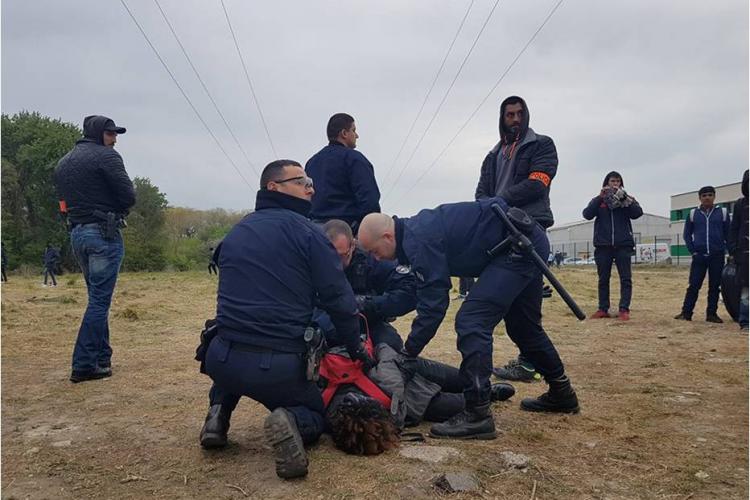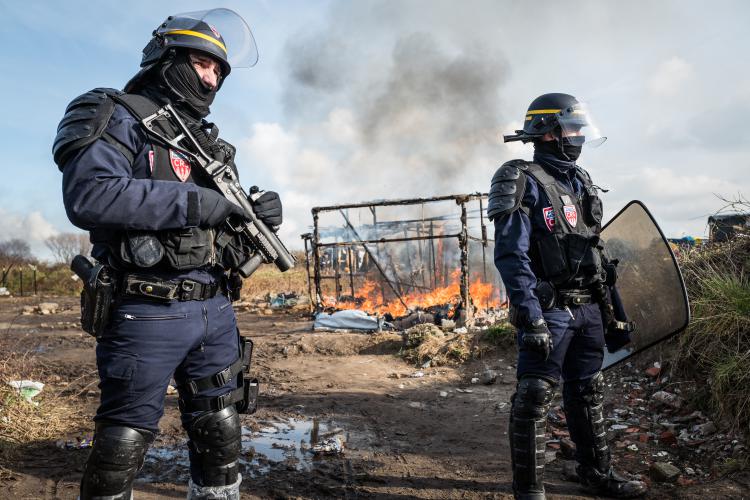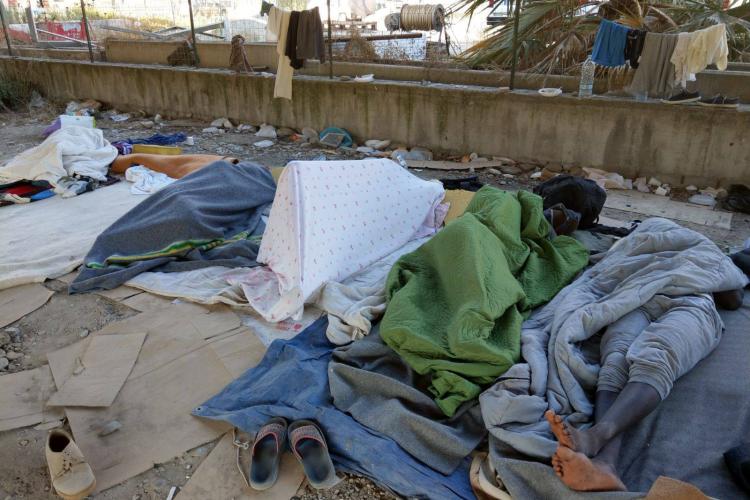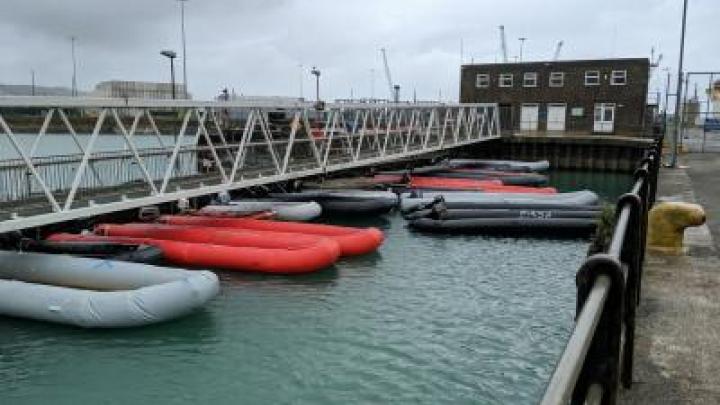Guilt through Punishment: Border Spectacles, State Violence and Public Attitudes towards Refugees and Displaced People
Posted
Time to read
Post by Marta Welander. Marta is a doctoral researcher and visiting lecturer in the Department of Politics and International Relations at the University of Westminster and executive director of Refugee Rights Europe. In this blog, she reflects on the sustained border violence witnessed in Europe, drawing on Hannah Arendt’s notion of ‘guilt through punishment’ and using field research findings from Calais and Ventimiglia to illustrate these ideas.
“Common sense reacted to the horrors of Buchenwald and Auschwitz with the plausible argument: ‘What crime must these people have committed that such things were done to them!’”. With these words, drawing on the Holocaust as an example, Hannah Arendt illustrates a notion of ‘guilt inferred from punishment’ through which public acceptance of, or in some cases support for, state violence is generated. If ‘these people’ hadn’t committed terrible wrongdoings, then why would state authorities inflict such horrific violence upon them? Similarly, in the context of the US-led war on Iraq in 2003, British scholar David Keen explains how a poll in February 2003 indicated that more than 70 per cent of Americans thought it was likely Saddam Hussein had been involved in the September 11 attacks despite the absence of any evidence. Keen suggests: ‘Given a certain level of trust in – and deference towards – the US government and the US President, guilt could to some extent be inferred from punishment.’ The scholar moreover suggests: ‘In any kind of conflict – whether international, ethnic or an international conflict with ethnic dimensions – an aura of legitimacy for violence can sometimes be generated by violence itself.’

To practitioners and scholars concerned with contemporary refugee rights and migration matters in Europe, it does not seem implausible that a similar dynamic might be at play in contemporary Europe. Polls have shown that security concerns are amongst the driving attitudes towards refugees and displaced people arriving in Europe, with a 2016 survey carried out by Pew indicating that more than half of respondents in eight out of ten countries researched were worried about the security implications of accepting refugees, despite there being little substantive evidence connecting refugee movements to terror attacks in the West. The same study indicated that fears linking refugees with criminal behaviour are prevalent as well, with nearly a third, or some 28%, in the UK and 24% in France say refugees are ‘more to blame for crime than other groups.’
While discursive analyses of media and political discourses linking migration with security threats (as well as concerns of economic and cultural nature) have allowed for a general conclusion to be drawn regarding the threat framing of migration and refugees through discourse, far less has been done to explore the links between state micro-practices at borders on the one hand (such as police brutality and sustained structural violence) and public attitudes towards refugees and displaced people on the other. While it is not the purpose of this article to prove a causal connection per se, it will be suggested that more attention should be directed not only to the impact of political narrative and media discourses on the public attitudes towards refugees, but also to the violent border practices of states. The potentially damaging impact of such practices - beyond the obvious immediate-term physical ailments and psychological harm – ought to be assessed with the view of establishing whether they might contribute to the long-term demonisation of newcomers and the normalisation of state violence against the same.
For instance, in the borderlands between Italy and France and France and Britain respectively, three countries often praised for their domestic human rights records, it is evident that structural and physical violence perpetrated against refugees and displaced people is commonplace. While there have been continued outcries by local organisations and national rights groups, the violence continues, with the wider public as silent bystanders.
Indeed, in Calais, the securitised border zone between France and Britain, and in Ventimiglia at the French-Italian border, Johan Galtung’s notion of structural violence is a daily reality for refugees and displaced people. As per Galtung’s definition, social structures and institutions are causing harm to individuals by preventing their basic needs being met; in both locations displaced people in their hundreds are sleeping rough without shelter. In Calais, they typically have their belongings confiscated or tear gassed on a regular basis. In Ventimiglia, repeated push-backs to south of Italy means that individuals have to travel more than a thousand kilometres to make it back to the border crossing, covering huge distances without access to state support, food or shelter. According to a recent study conducted by UNICEF and REACH in February 2017, protection risks facing unaccompanied minors in Ventimiglia are widespread, with children being left without recourse to international protection as they find themselves stranded in the town for considerable lengths of time under conditions characterised by high levels of insecurity. As also illustrated through in-depth research studies by Refugee Rights Europe throughout 2016-2017, living conditions in both locations have been wholly inadequate all along, characterised by untreated health conditions and little to no access to legal advice to break out of this cycle.

As regards physical violence, preeminent organisations such as the Bar Human Rights Committee and Human Rights Watch have issued reports evidencing alarming levels of police violence in Calais. An internal investigation by the French administration and security forces’ internal investigations departments in October 2017 similarly found evidence that police has used ‘excessive force and committed other abuses against child and adult migrants in Calais’. Meanwhile according to a survey conducted by Refugee Rights Europe with 233 refugees and displaced people in Calais in October 2017, a staggering 91.8% said they had experienced some form of police violence. 50.5% of these respondents said that the violence had taken the form of physical violence while 90.1% said they had experienced tear gas or pepper spray. While a significant proportion of the police violence tends to take place when individuals try to make their way to the UK, there were also an alarming number of instances of unprovoked police violence. For instance, more than 80% said they had been woken up by police whilst sleeping, often involving physical violence and tear gassing.
In Ventimiglia, another study conducted by Refugee Rights Europe in August 2017 found that more than a third of respondents (40.4%) had experienced violence by Italian police, which took the shape of tear gas or other forms of physical violence as well as verbal abuse. While most incidences of police violence in Ventimiglia appear to have taken place during attempted border crossings, other incidences were reported to have played out without any specific provocation. One 18-year old explained: ‘It was really bad. They came to me directly and they sprayed me with the gas on my face. I was really in a very bad situation by the river side of Ventimiligia.’ Across Europe, such violence against refugees and displaced people continues, with large segments of the public being seemingly complacent or favourable of such practices.

Of course, Calais has seen a number of serious outbreaks of violence amongst refugees, much like it has seen stone throwing against riot police and, of course, attempts to board UK-bound lorries. Most recently, a very serious outbreak of violence between Afghans and Eritreans in February this year led to some 22 people being sent to hospital. Such violent clashes between groups of displaced people in Calais undoubtedly feed straight into the dominant media discourse about the displaced people in Calais; one that frames the situation, and the refugees there, as a dangerous security threat. In Ventimiglia, unauthorised border crossings and resistance against police unfolds, albeit with less attention afforded to the situation by international media outlets.
However, what such imagery of the Calais and Ventimiglia ‘border spectacles’ fail to tell the public is the other side of the story; the story of ordinary people seeking a resolution to extended periods of suffering, violence and sub-par living conditions. It fails to illuminate how the current conditions in Calais and Ventimiglia may contribute towards refugees’ physical and mental exhaustion, deteriorating health, and sheer desperation through structural and physical violence, repeated dispersals and push-backs, evictions and the destruction of living spaces, coupled with a problematic absence of services, information and access to legal advice.
Therefore, the critical question for us all to pose here, is whether structural and physical violence perpetrated by powerful European states against refugees and displaced people might be causing far more long-lasting damage to our societies than the immediate physical ailments and mental health issues spurred on by such state practices, in that they may be contributing to the construction of a negative status of refugees and displaced people through the notion of ‘guilt through punishment’, and thus deepening the societal polarisation in Europe.
Any comments about this post? Get in touch with us! Send us an email, or post a comment here or on Facebook. You can also tweet us.
__________
How to cite this blog post (Harvard style)
Welander, M. (2017) Guilt through Punishment: Border Spectacles, State Violence and Public Attitudes towards Refugees and Displaced People. Available at: https://www.law.ox.ac.uk/research-subject-groups/centre-criminology/centreborder-criminologies/blog/2018/03/guilt-through (Accessed [date]).
Share
YOU MAY ALSO BE INTERESTED IN
With the support of









